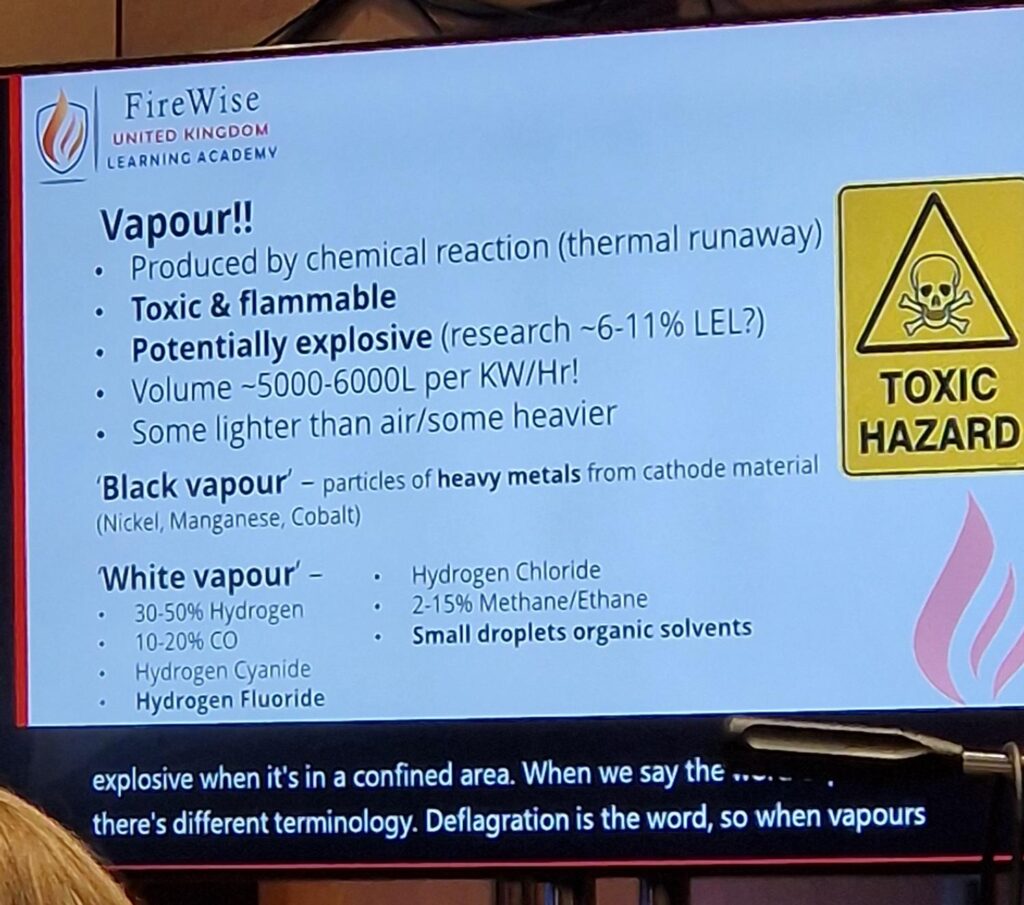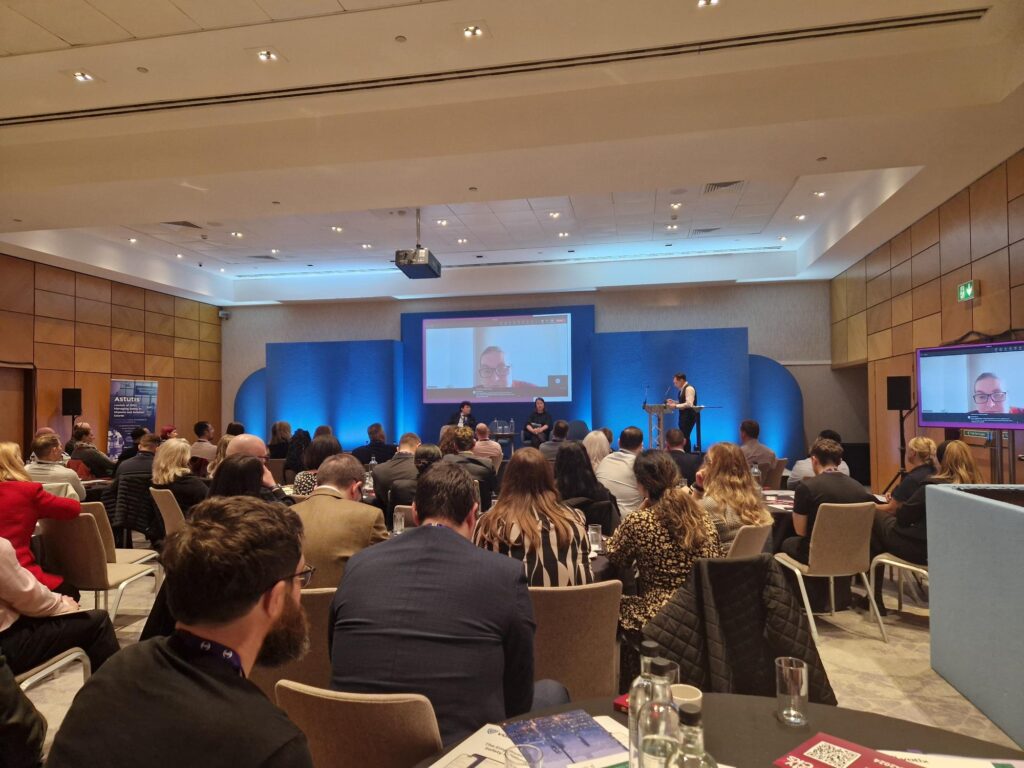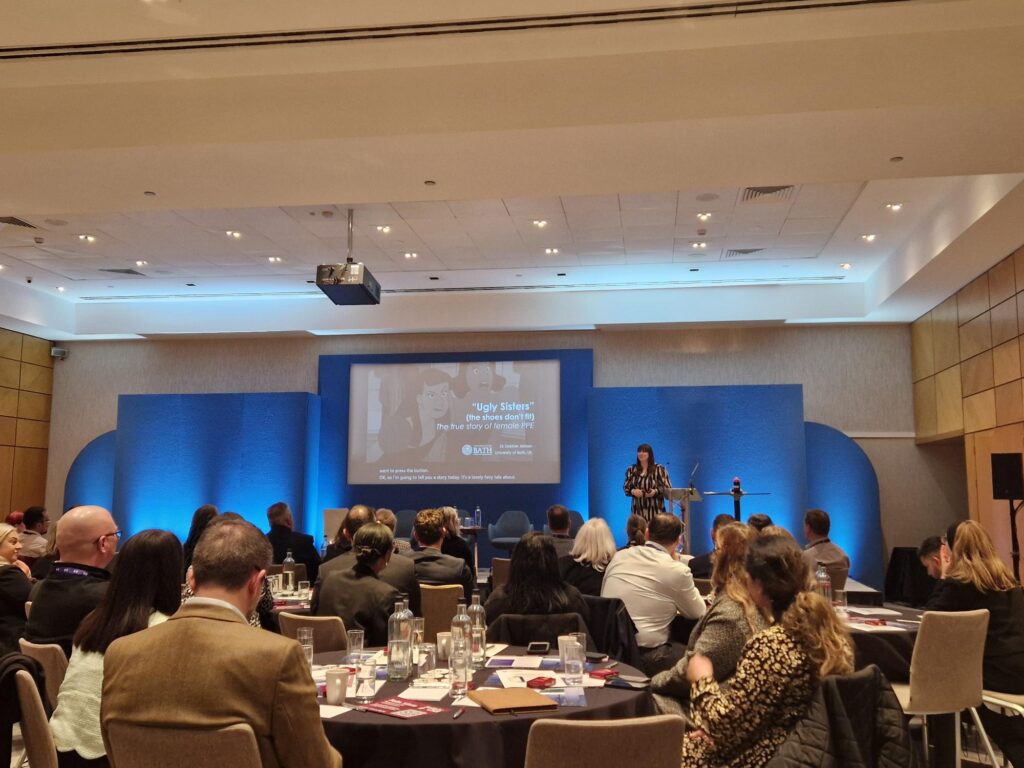Health and safety professionals from airports, carriers and maintenance firms came together for the event near London Heathrow Airport last month.
Hosted by Simon Toseland, Birmingham Airport’s Head of Health, Safety and Fire, the day covered topics high on the agenda for health and safety professionals including risk, inspections, PPE, mental health and design in safety. SHP’s Rhianna Sexton reports from the event.
Lithium-ion battery fires: ‘It’s not smoke, it’s toxic vapour from a chemical reaction’
Martin Lown, who has 30 years’ service in fire rescue and is now a specialist fire investigator at FireWise, wanted his presentation to be a ‘wake-up call’ to the risk of potential harm from lithium-ion batteries to people in the airport environment.
On lithium-ion batteries he said: “they’re great…they’re very efficient, powerful and there’s millions of them in the airport environment”.
Setting the scene in an airport, he described how this environment has lithium-ion batteries from lighting in buildings to the ‘unseen risk’ of alternative fuelled lorries delivering battery cargos back and forth from warehouses to aircraft holds, explaining just how dangerous they can be when unstable.
He mentioned two types of battery abuse: the first – non-energetic abuse – can be a manufacturing fault, with the chances of a faulty battery being one in 10,000. A number which starts to tally in comparison to the millions of batteries found in airports, posing a crucial risk. He also added that factors such as a short circuit or any chemical change in that battery “can make it go angry”.
Energetic failures, the second form of abuse, is due to physical damage. As an example, he described passengers running for flights, hurrying through security and dropping phones or laptops as they attempt to remove them from bags, or similarly battery packs being taken out of wheelchairs into cabin luggage, susceptible to varying temperatures, and overcharging equipment and devices.

A slide from Lown’s presentation
Lown explained the thermal runaway reaction process: “Once that chemical reaction starts, it’s exothermic, and it gives off an intense amount of heat which then causes a cascade through the battery pack…at some point those vapours that have been produced from that chemical process will burst out of the battery pack, and they will at some point reach their autoignition temperature to the point where they do transition to a fire.
“When you see a lithium-ion battery burning, it’s not just smoke, it is toxic, flammable explosive vapour and…the toxic vapours that come of a lithium-ion battery [have] long-term health impacts.”
He urged delegates to be aware of the risks and to spread the message to those travelling through airports who may be oblivious when around a lithium-ion battery in thermal runaway.
Describing what may be seen as ‘smoke’, Lown said: “The black vapour is the heavy metals coming out of the battery pack, so the likes of cobalt and nickel [which can cause] long-term health effects.
“The white vapour is what contains all the flammable gasses, so the hydrogens and methane…hydrogen cyanide and hydrogen fluoride…Hydrogen fluoride as a vapour, if you breathe that in, it goes into your lungs, mixes with the moisture inside your lungs and forms hydrochloric acid, and that will start burning your lungs from the inside out…so this is the importance of not breathing that vapour in.
“Most people are quite complacent about standing around an open fire or a bonfire…this is different, it’s not smoke, it’s a product of that chemical reaction,” Lown warned.
‘All roads lead to the client’
Mark Snelling, President of the Association of Project Safety focused on changes to the way building work is regulated and said that from April 2024, building control will be a regulated area and hold criminal liability if found to be incorrect. He warned airports as clients of design work, to be aware of the new requirements and understand how it will affect them – the new regulation aims to manage and maintain competency in the profession.
He explained: “You can’t operate as a building control inspector unless you are on the register, I mean this is a massive problem because I think they’ve only got 40% so far registered approval of the minimum number they need.”
On 14 March, HSE announced an extension period of 13 weeks from the 6 April to 6 July 2024 for professionals to apply to the register.
Snelling expanded on the change to duty holder requirements by saying: “In the past it used to be the person undertaking the work who was responsible, we now have ‘every duty holder is responsible’, and as we see in the construction management regulations, all roads lead to the client.”
However, he mentioned that clients try to get around regulations for design-sake, knowing there can be prosecutions and fines for building work that is not permitted, or not complying with minimum health and safety standards: “All of this is controlled by the Building Safety Regulator, which comes out of the HSE, and they have said ‘you will not give advice, you are a regulator, it is right or it is wrong’.
“Couple that with duty holder in confidence requirements, the world has changed, everybody has liability, you put something forward, it’s your responsibility to get it right, if you get it wrong, you’re liable to a criminal sanction.
“If there’s one message you get from all of this…many lead designers on projects will say ‘I don’t want to do this, can you get someone else to do this’, when you confront them with the fundamental principal [that is] whoever you give the contractual responsibility for the compliance must, in my view, take that criminally liability, [as] you cannot have two people – one criminally liable, one contractually responsible – they must be the same people…[and with this] the problems tend to get resolved.”
Supervision ‘lacking’ post-pandemic, says HSE
HSE Inspector, Nicola Jaynes, presented accident analysis in airport environments post-Covid: “Since the pandemic there’s been a change in incidents, prior to the pandemic around 80% of incidents within aviation all fell to manual handling really, baggage handling…it was always the biggest risk, I’m not saying that is no longer a big risk…but it has dropped, and over 25% of other accidents now are related to working at height. Unfortunately, those incidents have led to a number of fatalities within the industry.”

Nicole Jaynes speaking to delegates virtually
Speaking on data collected across England, Scotland, Wales and with HSE Northern Ireland, she said: “There’s themes emerging from those incidents…the supervision levels that were there pre-pandemic, are not there now. Whether that’s [due to] unfortunately having to lay off staff and you’ve not got those supervision levels back up to where they were, or the competence of that supervision [being] somewhat lacking.”
Addressing delegates, Jaynes added that during the pandemic ground service equipment was left outside with many affected by the changing weathers, and more susceptible to damage. “You should be having it looked at, you should be inspecting it before use…and unfortunately that doesn’t necessarily seem to be the case in all circumstances.”
On working at height, Jaynes said there had been ‘new issues identified’ when looking at London airports, including open gaps for handlers to navigate while loading baggage onto planes: “It should always be properly planned…[luggage] belt loaders were going up to the [aircraft] holds but unfortunately, they didn’t fill the gap.
“That gap is in some cases significant enough for a person to fall through. It doesn’t look that far, falling on to the tarmac, but unfortunately what that does mean is that you’re more likely to land on your head if you fall at that height.”
She added that the HSE are looking at different ways to fix these problems and speaking to manufacturers to reduce aircraft design issues that affect safety.
However, she concluded that safety culture is the long-term solution and reminded delegates of its importance: “I believe the industry had a reasonable safety culture pre-pandemic, and unfortunately…we’ve almost gone back 10-15 years…if it hasn’t happened to you, it doesn’t mean it won’t happen.”
Inclusive PPE
Debbie Janson a Lecturer from University of Bath, presented the results from a study around PPE for women. A mechanical engineer by trade, she explained that all of her jobs across various industries require her to wear PPE, however that everything is designed to fit the standard white western man, adding: “For me and for many women, PPE is not made for us and it doesn’t fit and that’s having a real impact on us on a day-to-day basis.

Debbie Jansen presenting at the event
“In every role, I noticed I was always going home with sore feet, or if I had to wear a helmet or a welding hat, I had headaches…and I thought it was me because I’m not a regular size 12 female, I thought everyone else was fine. But then I noticed they weren’t…and it was generally the women who were not fine.”
Through surveys, Janson found that 60% of females were uncomfortable with their safety footwear than they would be in regular footwear. However, she added that 45% of men were also uncomfortable, speaking of an overarching issue with PPE. Nearly half of females were keeping their footwear for over two years, which Janson said: “This is because we do tend to keep hold of footwear, we find something that fits and the same with other elements of PPE.”
Janson explained that there were two main issues with PPE, the first being range and the second fit; and while websites may include a female PPE section the range is limited or out of stock. She added: “Unisex is not a thing. If you see something labelled unisex and it’s meant to be fitting a women’s body, it will be designed around a man’s body shape.”
Janson mentioned a lot of women are forced to sow their own PPE to fit them properly, which can reduce high visibility areas. She also added that ergonomics can be affected by having to adjust gate for larger, ill-fitting PPE which can cause lower back issues, or crunching feet to keep shoes on.
Organisational culture is key to change, she said, adding: “A lot of the ladies we spoke to said they felt like a burden on their organisation. Their PPE didn’t fit, and they were told they could go back but they didn’t want to keep going back over and over again.”
She explained that in many organisations, women struggling to have PPE that fits were often simply given a budget and told to find their own and expense it: “That’s good because I get my own choice right? But why would I have to do that when all my male colleagues are catered for and don’t have to do this?”
Jansen urged organisations critically review what PPE is being offered to employees: “Appropriate PPE clearly leads to improved safety…but it can also increase productivity…but more importantly, we’re talking more and more about wellbeing, the sense of belonging, the sense of moral, the sense of professionalism and capability is so important for the wellbeing of your employees, particularly for women.”
The Safety Conversation Podcast: Listen now!
The Safety Conversation with SHP (previously the Safety and Health Podcast) aims to bring you the latest news, insights and legislation updates in the form of interviews, discussions and panel debates from leading figures within the profession.
Find us on Apple Podcasts, Spotify and Google Podcasts, subscribe and join the conversation today!





Great article Rhianna, it was a pleasure to meet you and have you at the event. See you next year.
Thank you Simon – lovely to meet you too and look forward to next year’s!